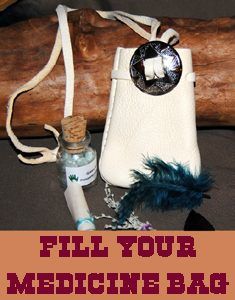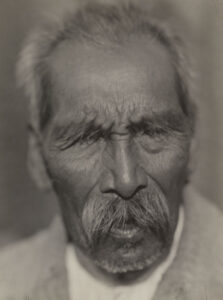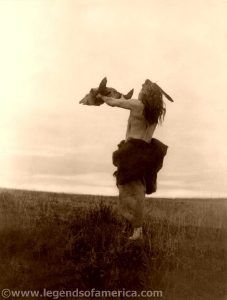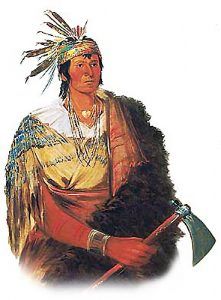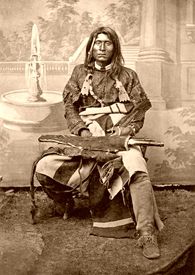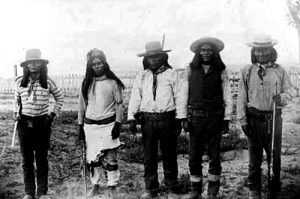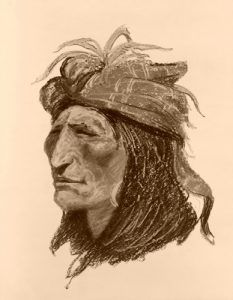Summaries: A B C D E-I J-K L-M N O P Q-R S T-V W X-Z
Lakota or Lakhota – Lakota is the name that this branch of the Sioux give themselves and means “Allies” or “Confederates,” expressing their intimate relationship with the Dakota and Nakota. Known more fully as the Teton Lakota, they were allied with the Cheyenne and Arapahoe. In the 17th century, but were driven west by the Anishinaabe, who had acquired guns from the French. In their westward progress, they drove the Kiowa out of the Black Hills in 1765. Their other chief enemies were the Pawnee, the Crow, and the Arikara. They adapted to their new environment and became practitioners of the Plains’ Culture. They are most famous for leading their allies to victory over George Armstrong Custer at the Little Big Horn in 1876.
Lithic Stage – See Paleo Indian
Lenape – See Delaware.
Lumbee – The Lumbee are original residents of North Carolina, primarily Robeson County, where they still live today. Unlike most Indian tribes in the United States, the Lumbee Indians do not have a reservation or recognized tribal leadership. The Lumbees own their land and have a strong community, but they are considered regular U.S. and North Carolina citizens and do not have sovereignty rights. Some Lumbee people are dissatisfied with this situation and are working to change it.
Mahican – A confederacy of Native People of the Eastern Woodlands with an Algonquian language. They occupied both banks of the Hudson River, almost to Lake Champlain. The Mohegan were a tribe of the Mahican group; both have been called Mohicans. By 1664 the Mohawk had driven the Mahicans East to Massachusetts. Their complete dispersal was hastened when the Dutch armed their enemies.
Maidu – The Maidu are a Native American people of northern California who lived from the crest of the High Sierra, west to the Sacramento River and south to the Consumnes River. Collectively known as the Maiduan, four groups of closely related people have inhabited the land for thousands of years.
Maliseet – The Maliseet Nation was a member of the Wabanaki Confederacy that controlled much of New England and the Canadian Maritimes. The Maliseet were original natives of the area between Maine and New Brunswick. Today, most Maliseet live on the Canadian side of the border, in New Brunswick and Quebec, except for one band that lives in Maine.
Mandan – These indigenous people of the Plains spoke a Siouan language. Said to have come from the East, by the mid-18th century, they lived in North Dakota.
Mascouten – Mascouten apparently comes from a Fox word meaning “little prairie people.” The first occupied parts of southwestern Michigan but abandoned their location and joined Algonquin tribes in Wisconsin after being attacked by the Ottawa and Neutral tribes. Continuing to move south and westward, the Mascouten tribe was eventually assimilated into the Algonquin, Wabash, Kickapoo, and other groups until they were completely absorbed.
Massachusett – Contact with Europeans probably occurred early, perhaps as soon as John Cabot in 1497. They were first mentioned by Captain John Smith when he explored the coast of New England in 1614. Disaster struck immediately afterward through three epidemics that swept New England between 1614 and 1617, destroying 3/4 of the original native population. No organized groups of the Massachusett are known to have survived after 1800.
Mattabesic – Mention is often made of the Wappinger and Mattabesic Confederations, but these organizations never existed. In truth, the Mattabesic and Wappinger were not even tribes within the word’s usual meaning. They were a collection of a dozen or so small tribes which spoke Algonquin, shared a common culture, and occupied a defined geographic area. The name of the Mattabesic comes from a single village on the Connecticut River near Middletown.
Menominee – Part of the Algonquian language family, the Menominee originally lived on and near the Menominee River in Wisconsin.
Metoac – The Metoac had the misfortune to occupy Long Island, regarded as the best land in the Northeast. Each summer from the waters of Long Island Sound, the Metoac harvested clam shells which, during the winter, were painstakingly fashioned into small beads they called “wampumpeag” – shortened later by the English into the more familiar form “wampum.” The population of all Metoac tribes in 1600 was about 10,000, but the combined effects of warfare and epidemics left the Metoac at less than 500 by 1659. Today, there are two reservations on Long Island: the Shinnecock, with nearly 400 residents, and the 200 Unkechaug at the Poospatock Reserve. Besides those on the reservations, more than 1,400 Metoac live in the immediate area. Although state recognition of the Shinnecock and Unkechaug dates from the colonial period, because they have never signed treaties with the United States, neither tribe is federally recognized.
Miami – Originally from northern Indiana and the adjacent areas of Illinois and Ohio, the Miami had the reputation of being slow-spoken and polite with an inclination towards elaborate dress, especially among their chiefs.
Mi’kmaq – Also simplified to Micmac, this tribe was indigenous to Canada’s Atlantic Provinces, the Gaspé Peninsula of Quebec, as well as the northeastern region of Maine. With the Beothuk on Newfoundland, the Mi’kmaq were probably the first Native Americans to have regular contact with Europeans. This may have occurred as early as the 11th century with the early Viking settlements on the coast of North America or perhaps with Basque fishermen who visited the Grand Banks before Columbus’ voyage in 1492 but kept quiet about where they were catching all their fish. The Mi’kmaq people live in their original homeland in Nova Scotia today, where they are fighting for the right to fish and hunt as their ancestors used to.
Mingo – A name given by Anglo-Americans to a group of Iroquoian-speaking peoples, primarily Seneca and Cayuga, who migrated to Ohio Country in the mid-1700s.
Missouria – The Missouria or Missouri Indians, a Siouan tribe, lived in and gave their name to the state of Missouri. Their name means “one who has dugout canoes” in the Illinois language. In their language, the Missouria called themselves Niúachi.
Miwok – Also spelled Miwuk or Me-Wuk – refers to several Native American groups who spoke the Miwokan language and lived in northern California. The word “Miwok” means people in their native language. Generally, the Miwok hunted and gathered people who lived in small bands without centralized political authority before contact with white settlers.
Modoc – The Modoc, meaning “southerners,” were a warlike and aggressive offshoot from the Klamath tribe of southeast Oregon, occupying the territory immediately to the south of the latter, extending across the California border including the Lost River Country and the famous Lava-bed region. After the Modoc War, they were confined to reservations in Oregon and Oklahoma.
Mogollon – One of four major prehistoric archaeological culture areas of the American Southwest and Northern Mexico, the Mogollon lived in the southwest from approximately 150 A.D. until about 1450 A.D.
Mohegan – A federally recognized tribe and sovereign tribal nation with a reservation on the Thames River in Uncasville, Connecticut. They were historically based in central southern Connecticut and were originally part of the Pequot people.
Mohican – Frequently confused with the Mohegans due to a poorly-researched literary classic. The Mohican tribe was not driven to extinction but was exiled to Wisconsin.
 Mohawk – Of the Iroquoian linguistic stock and Eastern Woodlands area, the Mohawk were once the chief people of the Five Nations of the Iroquoian Confederacy. Their first contact with the European settlers resulted in conflict, fighting against Samuel De Champlain. Dutch explorers managed to trade with the Mohawk, exchanging rifles for furs. In later years, the British allied with the Mohawk to fight the French and American colonists. After the American Revolution, most of the Mohawk relocated to Canada, where the vast majority still reside today.
Mohawk – Of the Iroquoian linguistic stock and Eastern Woodlands area, the Mohawk were once the chief people of the Five Nations of the Iroquoian Confederacy. Their first contact with the European settlers resulted in conflict, fighting against Samuel De Champlain. Dutch explorers managed to trade with the Mohawk, exchanging rifles for furs. In later years, the British allied with the Mohawk to fight the French and American colonists. After the American Revolution, most of the Mohawk relocated to Canada, where the vast majority still reside today.
Mojave – Living along the banks of the Lower Colorado River in California and Arizona, their tribal structure was based on the family unit. They practiced agriculture, growing corn, and beans, amongst other things, and were also skilled at fishing and hunting. Their belief system was based on a singular supreme entity, and their value system revolved around courage in battle. There are currently around fifteen hundred Mojave Indians living on reservations in Arizona.
Montagnais – Nitassinan, the Montagnais homeland, is a vast area that includes most of Quebec east of the St. Maurice River, extending along the north side of the St. Lawrence to the Atlantic Ocean in Labrador. Diet relied heavily on the hunting of moose and seals but with a heavy reliance on fishing for salmon and eel. Montagnais considered porcupines a delicacy. So much so that they were sometimes referred to as the “Porcupine Indians.” There are almost 13,000 Montagnais in Quebec, with another 800 living in Labrador.
Munsee – The name derives from the people’s original band name, Minisink, which means “from the rocky land.” The Munsees originally lived in the mid-Atlantic, in areas that are now southern New York, northern New Jersey, and southeastern Connecticut. Dutch and British colonists forced them to leave their homeland in the 1700s. Some of them retreated to Canada, where most Munsee live today. Others joined the Mahican Indians in New York; the two tribes were deported to Wisconsin, where they live together today. Still, others sought shelter with their relatives the Delaware (Lenape) and continue to live among them now.
Muskogean – A language family containing Alabama, Apalachee, Calusa, Chickasaw, Choctaw, Coushatta, Creek, Hitchiti, Seminole, and Yamasee tribes. Initially, they were confined chiefly to the Gulf states east of almost all Mississippi and Alabama and parts of Tennessee, Georgia, Florida, and South Carolina. According to a tradition held in common by most of their tribes, they had reached their historic seats from some starting point west of the Mississippi River, usually placed somewhere on the upper Red River. Later, most were moved to Indian Territory.
Summaries: A B C D E-I J-K L-M N O P Q-R S T-V W X-Z
© Kathy Alexander/Legends of America, updated March 2023.
Also See:
Native American Photo Galleries

